Accidents and Incidents Related to Eruptive Fire Behavior in Greece
Abstract
:1. Introduction

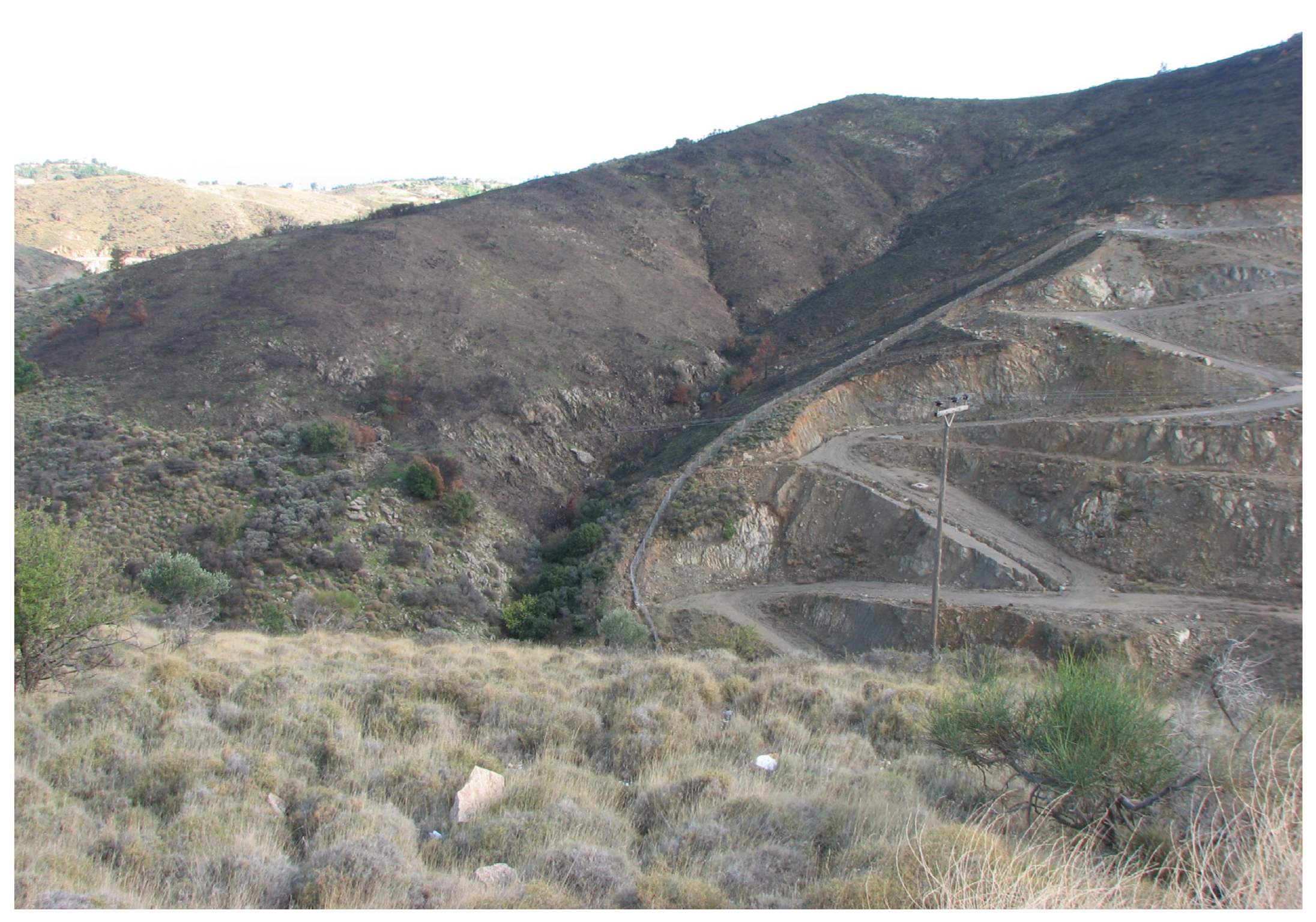
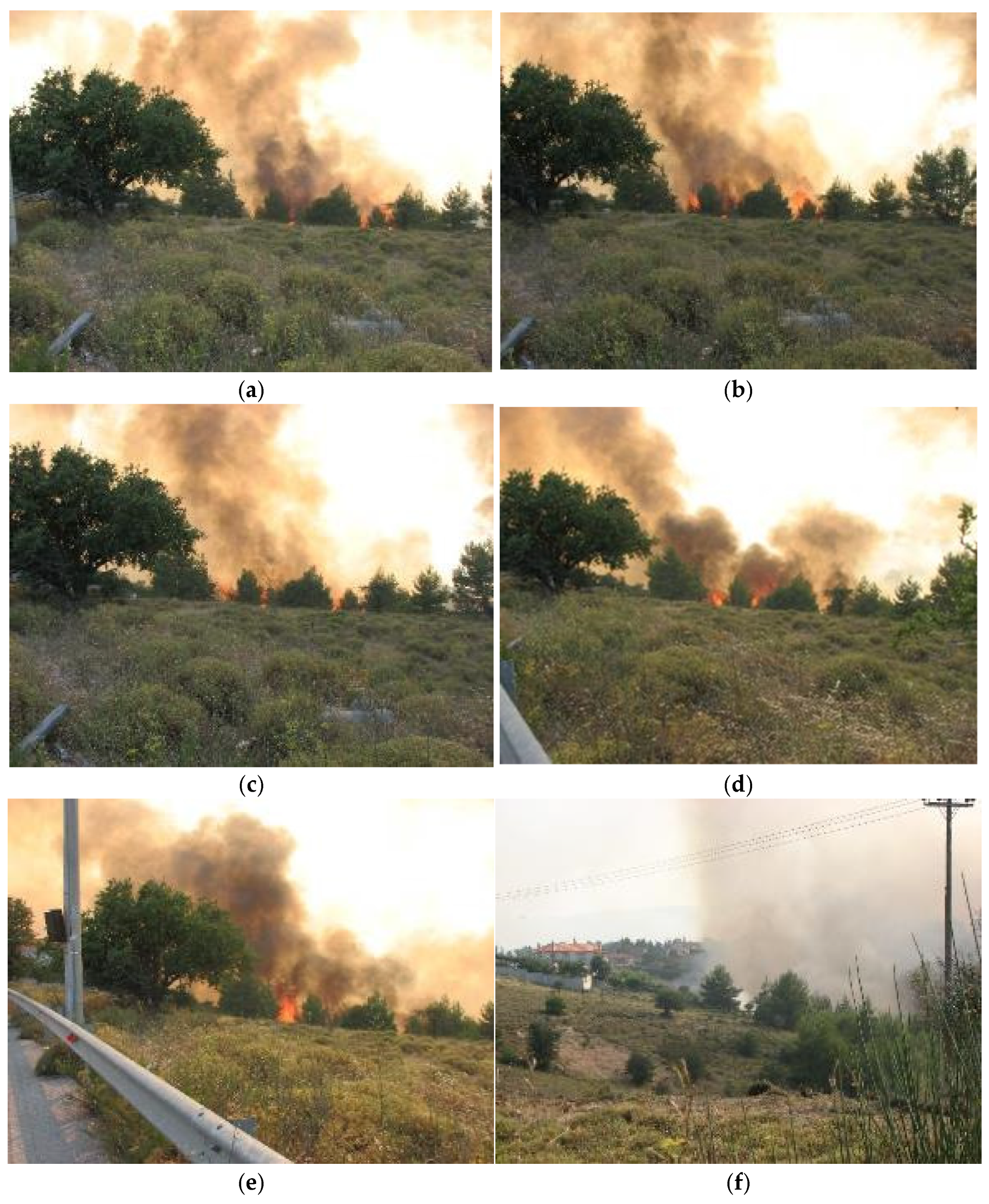
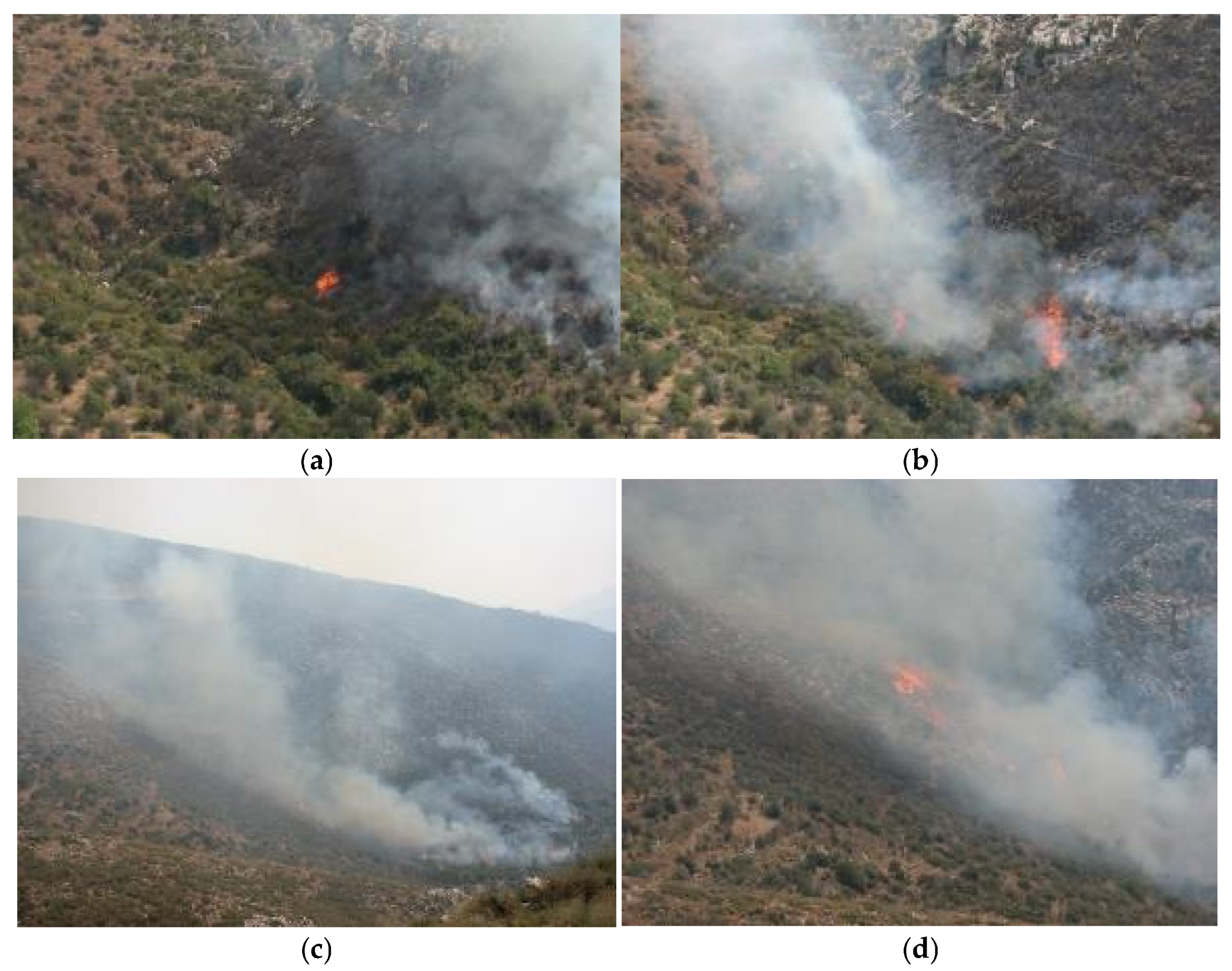
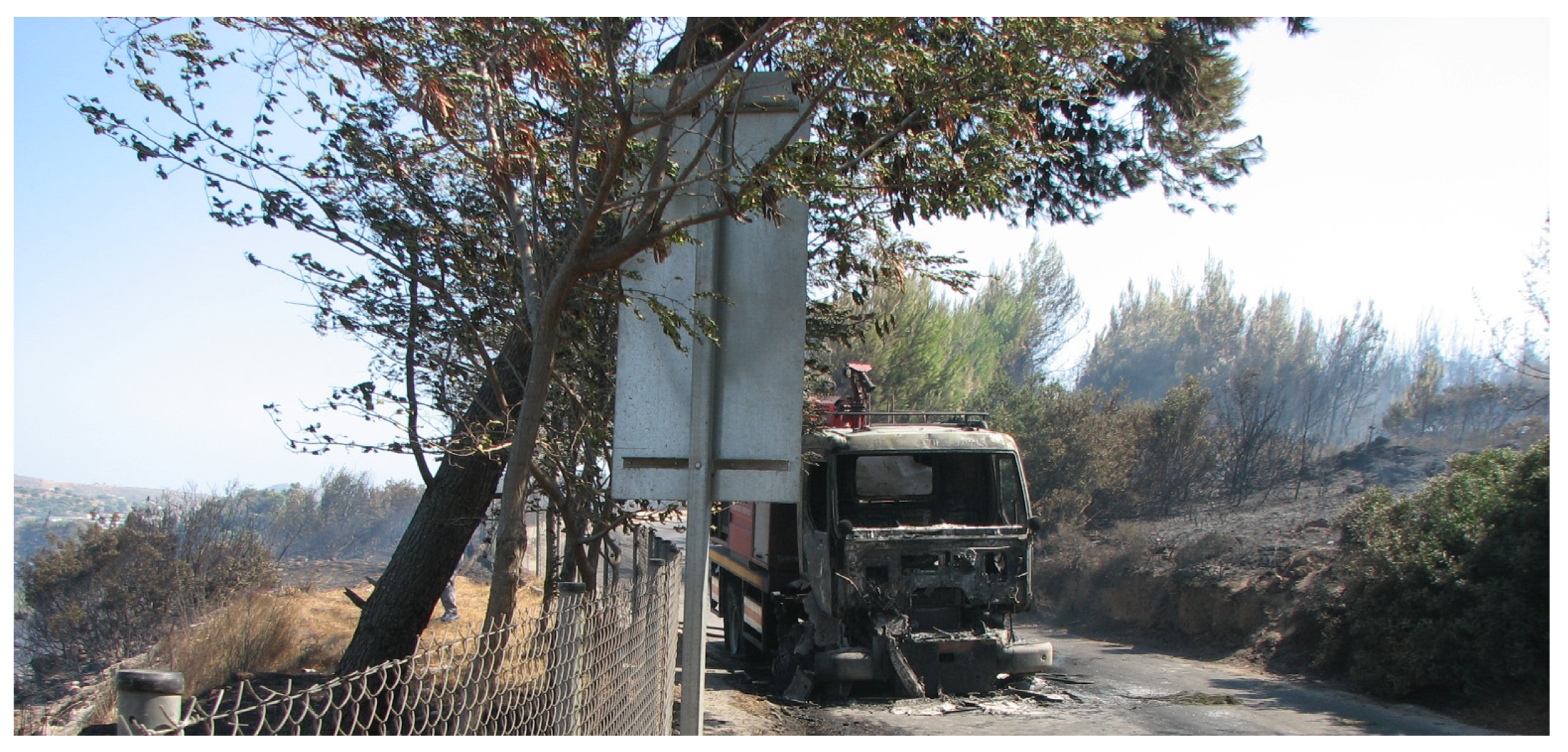
2. Materials and Methods
- (a)
- Twelve wildfires that caused 46 fatalities (13 firefighters and 33 citizens either on site or later in the hospital) and injured 6 people (2 firefighters and 4 citizens) in 15 accident sites
- (b)
- Six cases of “chimney effect” and “flame attachment” occurrence that caused no deaths or injuries and were recorded in the field.
- (a)
- living members of fire engine or hand crews and professional and volunteer firefighters who had worked on those fires and were interviewed, either at the accident site during later visits or elsewhere;
- (b)
- interviews with locals at the accident sites;
- (c)
- data from our field measurements and archives;
- (d)
- data, photos, video footage and information either reported by public agencies or published by citizens via mass and social media.

- (a)
- The shortest ground distance (m), which is the shortest true distance over the surface, considering the topography of the area, between the body or injured person and the closest canyon/gorge bed (ds_cg, m);
- (b)
- The maximum grade along the axis (bed) of the closest canyon/gorge (cg_mxgr, %);
- (c)
- The mean grade of the ground along which the fire finger of interest had spread (either along the closest canyon/gorge bed or across a side slope) (fs_mngr, %);
- (d)
- The maximum grade of the ground along which the fire finger of interest had spread, (either along the closest canyon/gorge bed or across a side slope) (fs_mxgr, %);
- (e)
- The shortest ground distance between the body or injured person and the unburned vegetation (ds_vg, m);
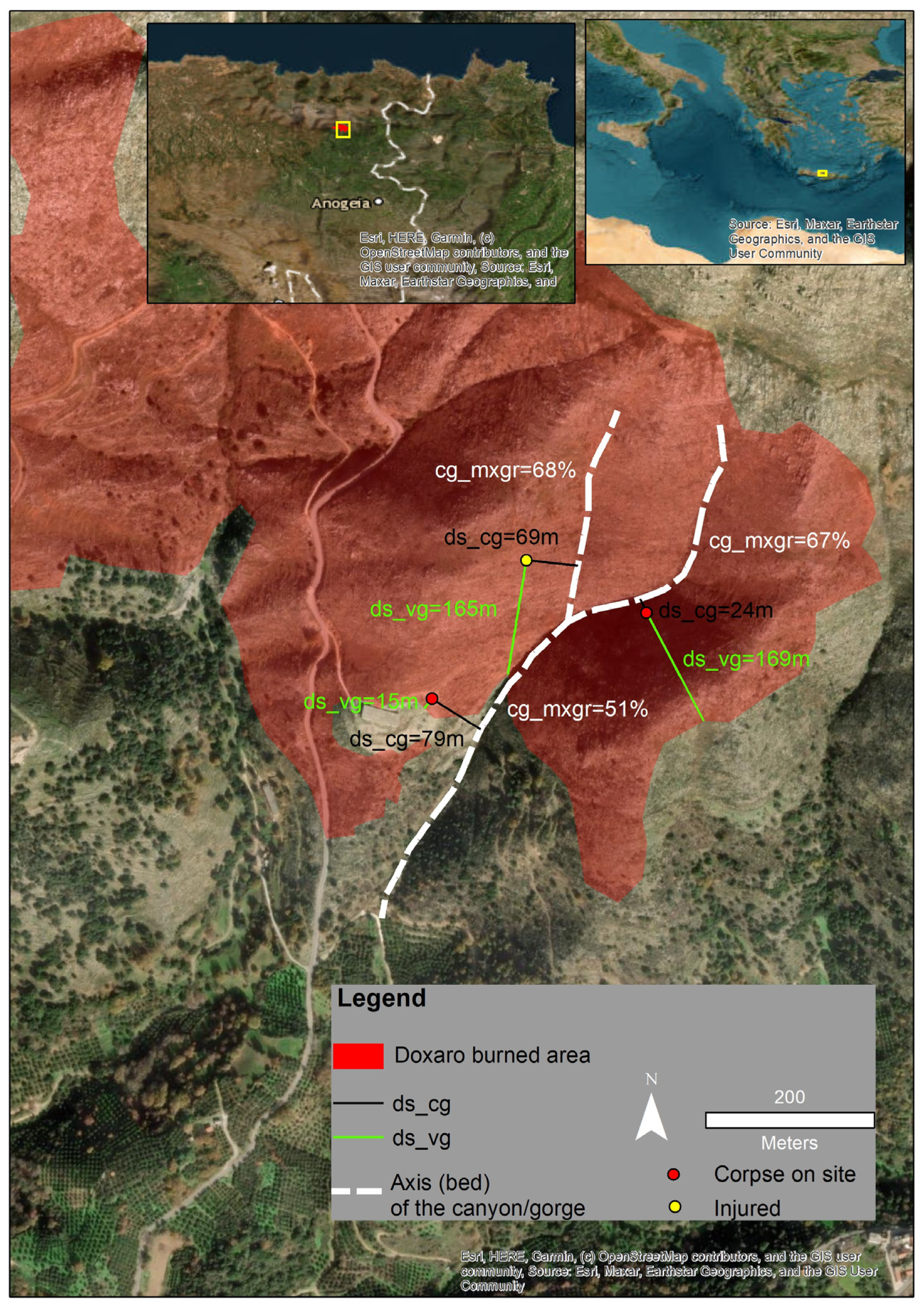
- (f)
- The distance along road or trail between the body or injured person and the closest wildfire-resilient structure (ds_rstr, m). This was only calculated for citizens.
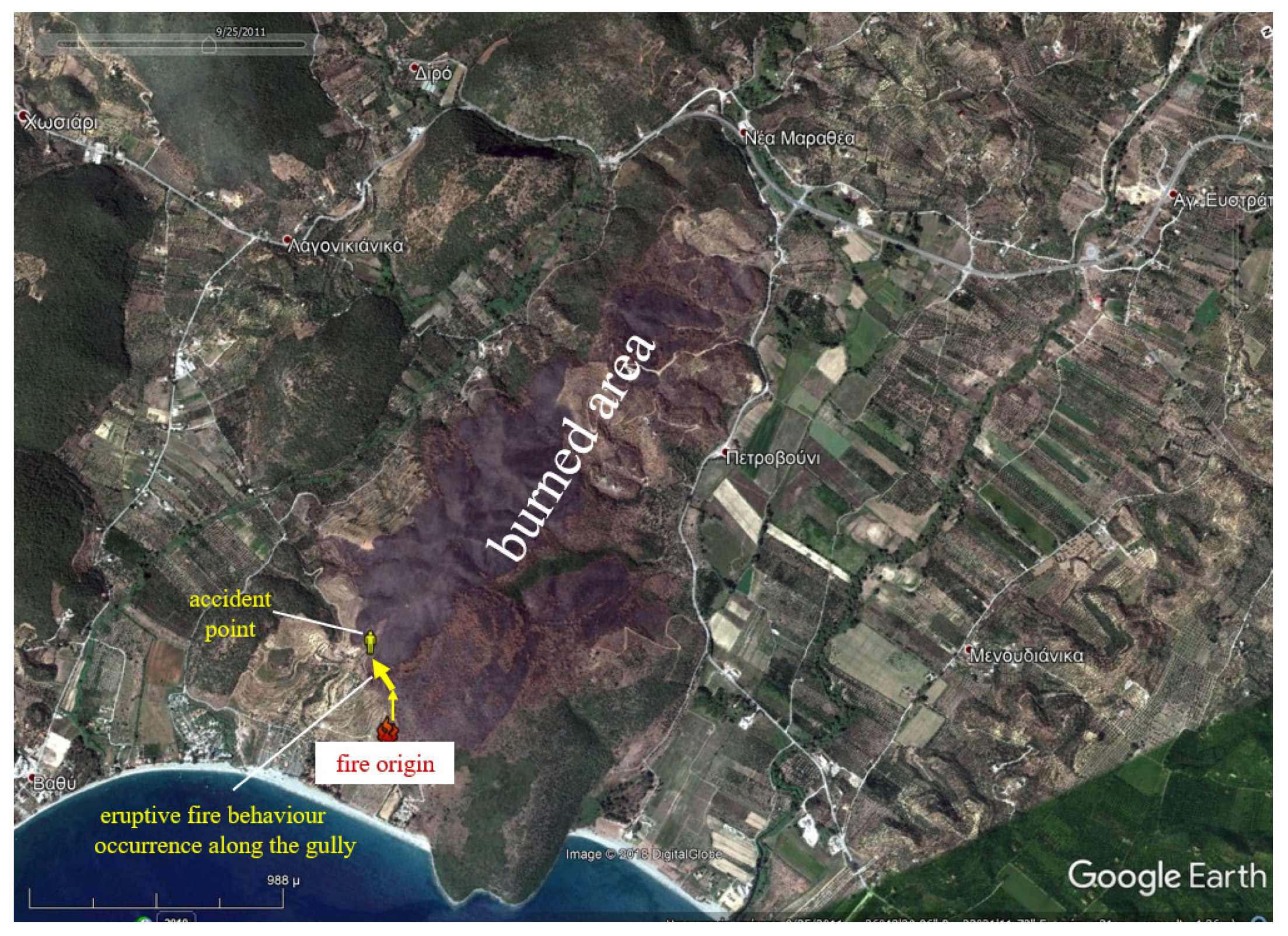
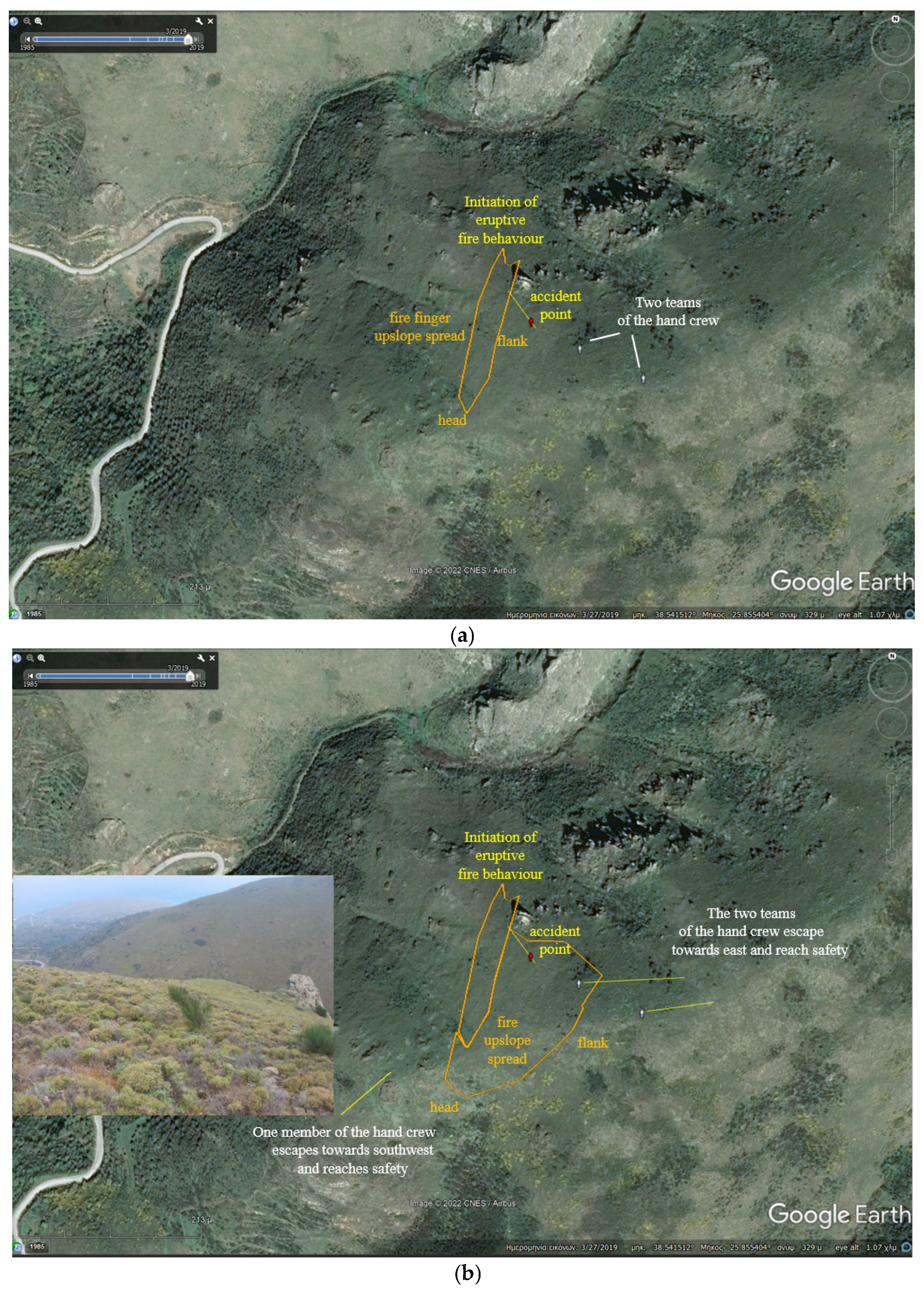
3. Results
| Fatalities | |||||||||
|---|---|---|---|---|---|---|---|---|---|
| Case. Wildfire (Accident Site), Year | Forest Fuels | fs_mngr-fs_mxgr (%) | Wind Influence | Fire Type | ROS (m·min−1) | Corpses on Site | Died in the Hospital | Injured | Victims |
| 1. Patra (Aroi), 1982 | Reeds, grass and phrygana | 48–56 | N/A | surface | N/A | 0 | 1 | 0 | Firefighter |
| 2. Ikaria (south) 1, 1993 | Tall shrubs | 20–68 | N/A | N/A | N/A | 5 | 0 | 0 | Citizens |
| 2. Ikaria (north) 1, 1993 | Tall shrubs | 21–72 | N/A | N/A | N/A | 7 | 0 | 0 | Citizens |
| 3. Hymettus, 1998 | Pine forest with phrygana understory | 25–66 | no | active crown | N/A | 4 | 0 | 0 | Firefighters |
| 4. Chios (Melanios), 1999 | Phrygana | 43–49 | yes | surface | 240 | 1 | 1 | 1 | Firefighters |
| 5. Epirus, (Agia Marina) 2, 2000 | Tall shrubs and oaks | 12–78 | yes | active crown | N/A | 3 | 0 | 0 | Citizens |
| 5. Epirus, (Lavdani) 2, 2000 | Tall shrubs and oaks | 16–46 | yes | active crown | N/A | 3 | 0 | 0 | Citizens |
| 5. Epirus, (Rizo) 2, 2000 | Tall shrubs and oaks | 44–84 | yes | active crown | N/A | 1 | 0 | 0 | Citizens |
| 6. Crete (Doxaro), 2007 | Phrygana | 38–67 | no | surface | N/A | 3 | 0 | 1 | Firefighters |
| 7. Lakonia (Neo Oitylo), 2007 | Phrygana and grass | 11–34 | no | surface | N/A | 5 | 0 | 0 | Citizens |
| 8. Arcadia (Leontari), 2007 | Tall shrubs and oaks | 20–43 | yes | active crown | N/A | 4 | 0 | 0 | Citizens |
| 9. Euboea (Mistros), 2007 | Pine forest | 12–101 | yes | active crown | N/A | 4 | 1 | 1 | Citizens Firefighters |
| 10. Lakonia (Vathy), 2011 | Phrygana and tall shrubs | 21–36 | yes | surface | 200 | 1 | 0 | 0 | Firefighter |
| 11. Hymettus, 2015 | Phrygana and young pines | 28–66 | N/A | surface | N/A | 1 | 0 | 0 | Citizen |
| 12. Chios (Sidirounda), 2016 | Phrygana | 19–55 | yes | surface | N/A | 0 | 1 | 3 | Citizens |
| 42 | 4 | 6 | |||||||
| ds_cg (m) | cg_mxgr (%) | fs_mngr (%) | fs_mxgr (%) | ds_vg (m) | ds_rstr (m) | |
|---|---|---|---|---|---|---|
| Mean | 68 | 58 | 24 | 59 | 1261 | 443 |
| Standard Error | 9 | 2 | 2 | 3 | 337 | 71 |
| Median | 34 | 55 | 21 | 64 | 226 | 221 |
| Mode | 30 | 74 | 20 | 72 | 226 | 965 |
| Standard Deviation | 64 | 16 | 11 | 19 | 2106 | 406 |
| Minimum | 2 | 26 | 11 | 26 | 15 | 4 |
| Maximum | 220 | 101 | 59 | 101 | 7066 | 1562 |
| Ν | 52 | 52 | 52 | 52 | 39 | 33 |
| Wildfire (Incident Site), Year | Forest Fuels | Wind Influence (Figure) | Fire Type | FDFMC (%) fs_mngr (%) ROS (m·min−1) |
|---|---|---|---|---|
| 1. Arcadia (Maratha), 2007 | Phrygana, grass, and shrubs | No (4) | surface | 5-119-150 |
| 2. Hymettus, 2009 | Phrygana and low shrubs | No (10a) | surface | 5-54-N/A |
| 3. NE Attica (Dioni), 2009 | Low shrubs and young pine trees | Yes (5) | surface | 8-100-N/A |
| 4. Lakonia (Chosiario), 2012 | Phrygana and low shrubs | Yes (10b) | surface | 3-45-N/A |
| 5. Attica (Kalamos), 2017 | Phrygana | Yes (3) | surface | 9-22-N/A |
| 6. Chios (Korakaris), 2019 | Phrygana, tall shrubs and grass | No (2) | surface | 12-36-300 |
| A/I | Year | Wind Influence | Eye-Level Wind Speed (km/h) | RH (%) | T (°C) | fs_mngr-fs_mxgr (%) | Aspect of the Location | Forest Fuels (Surface Fuel Load, kg∙m−2)- FDFMC (%) | ROS (m·min−1) |
|---|---|---|---|---|---|---|---|---|---|
| Chios (Melanios)-A | 1999 | Yes | 25 | N/A | N/A | 43–49 | N | Phrygana (0.57)-N/A | 240 |
| Arcadia (Maratha)-I | 2007 | No | 0 | 29 | 43 | 119–142 | S | Phrygana, grass, and shrubs (1.42)-5 | 150 |
| Vathy, Peloponnese-A | 2011 | Yes | 15 | 40 | 33 | 21–36 | E | Phrygana and tall shrubs (2.57)-8 | 200 |
| Hymettus-A | 2015 | No | 35 | 31 | 31 | 25–67 | W | Phrygana and young pines (1.23)-6 | 150 |
| Hymettus-A | 2015 | No | 35 | 31 | 31 | 27–133 | W | Phrygana and young pines (1.23)-6 | 130 |
| Chios (Korakaris)-I | 2019 | No | 25 | 57 | 25 | 36–53 | E | Phrygana, tall shrubs and grass (1.90)-12 | 300 |
4. Discussion—Conclusions
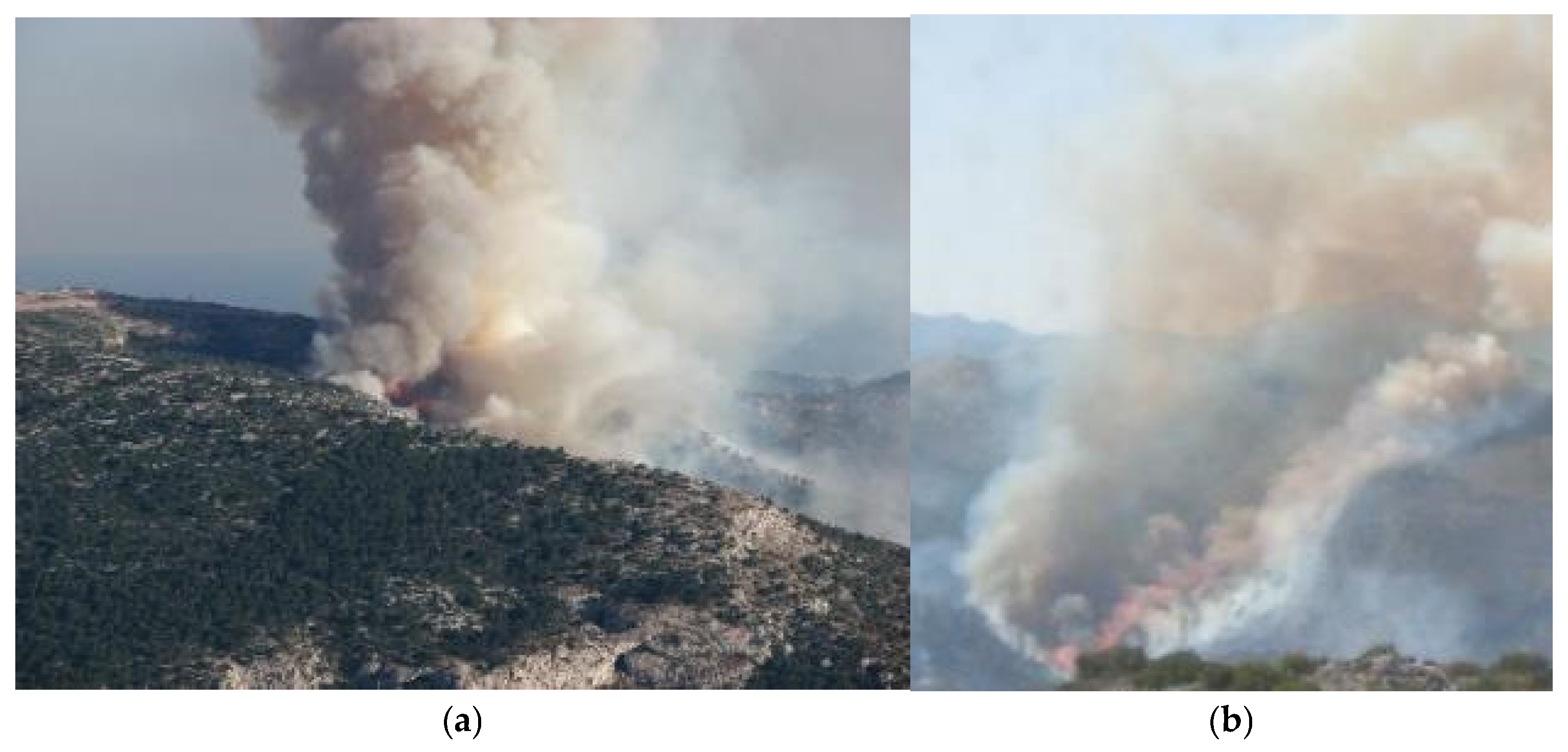
Author Contributions
Funding
Institutional Review Board Statement
Informed Consent Statement
Data Availability Statement
Acknowledgments
Conflicts of Interest
References
- Mangan, R.J. Wildland Firefighter Fatalities in the United States: 1990–2006; US Forest Service, Missoula Technology and Development Center: Missoula, MT, USA, 2007.
- Diakakis, M.; Xanthopoulos, G.; Gregos, L. Analysis of forest fire fatalities in Greece: 1977–2013. Int. J. Wildland Fire 2016, 25, 797–809. [Google Scholar] [CrossRef]
- Molina-Terrén, D.M.; Xanthopoulos, G.; Diakakis, M.; Ribeiro, L.; Caballero, D.; Delogu, G.M.; Viegas, D.X.; Silva, C.A.; Cardil, A. Analysis of forest fire fatalities in Southern Europe: Spain, Portugal, Greece and Sardinia (Italy). Int. J. Wildland Fire 2019, 28, 85–98. [Google Scholar] [CrossRef]
- Haynes, K.; Short, K.; Xanthopoulos, G.; Viegas, D.; Ribeiro, L.M.; Blanchi, R. Wildfires and WUI Fire Fatalities. In Encyclopedia of Wildfires and Wildland-Urban Interface (WUI) Fires; Manzello, S.L., Ed.; Springer International Publishing: Cham, Switzerland, 2019; pp. 1–16. [Google Scholar] [CrossRef]
- Rothermel, R.C. Mann Gulch Fire: A Race that Couldn’t Be Won; Gen. Tech. Rep. INT-GTR-299; U.S. Department of Agriculture, Forest Service, Intermountain Research Station: Ogden, UT, USA, 1993; p. 10.
- Butler, B.W.; Bartlette, R.A.; Bradshaw, L.S.; Cohen, J.D.; Andrews, P.L.; Putnam, T.; Mangan, R.J. Fire Behavior Associated with the 1994 South Canyon Fire on Storm King Mountain, Colorado; Res. Pap. RMRS-RP-9; US Department of Agriculture, Forest Service, Rocky Mountain Research Station: Ogden, UT, USA, 1998; Volume 9, 82p.
- Dold, J.; Zinoviev, A. Fire eruption through intensity and spread rate interaction mediated by flow attachment. Combust. Theory Model. 2009, 13, 763–793. [Google Scholar] [CrossRef]
- Stipanicev, D.; Viegas, D. The Accident of Kornati (Croatia) 2007; Technical Report for Recent Forest Fire Related Accidents in Europe; JRC: Brussels, Belgium, 2009; p. 26. [Google Scholar]
- Viegas, D.; Caballero, D. The Accident of Guadalajara (Spain) 2005; Technical Report for Recent Forest Fire Related Accidents in Europe; JRC: Brussels, Belgium, 2009; pp. 3–17. [Google Scholar]
- Xanthopoulos, G.; Viegas, D.X.; Caballero, D. The Fatal Fire Entrapment of Artemida (Greece) 2007; Technical Report for Recent Forest Fire Related Accidents in Europe; JRC: Brussels, Belgium, 2009; p. 65. [Google Scholar]
- Castellnou, M.; Guiomar, N.; Rego, F.; Fernandes, P.M. Fire growth patterns in the 2017 mega fire episode of October 15, central Portugal. Adv. For. Fire Res. 2018, 447–453. [Google Scholar]
- Athanasiou, M.; Dimakogiannis, D. Wildfire behaviour associated with the August 22, 2011 accident in Vathy, Lakonia, Greece. Firef. Rev. 2018, 189, 4–9, (In Greek with English Abstract). [Google Scholar]
- Athanasiou, M.; Xanthopoulos, G. The behaviour of the deadly wildfire of 23 July 2018, in Northeastern Attica, Greece. In Proceedings of the 20th Hellenic Forestry Conference 900 p., Trikala, Greece, 3–6 October 2021; pp. 64–72, (In Greek with English Abstract). [Google Scholar]
- Dold, J.; Simeoni, A.; Zinoviev, A.; Weber, R. The Palasca Fire, September 2000: Eruption or Flashover; Technical Report for Recent Forest Fire Related Accidents in Europe; JRC: Brussels, Belgium, 2009; p. 54. [Google Scholar]
- Wilson, C.C. Fatal and near-fatal forest fires: The common denominators. Int. Fire Chief 1977, 43, 9–15. [Google Scholar]
- Viegas, D.X. A mathematical model for forest fires blowup. Combust. Sci. Technol. 2004, 177, 27–51. [Google Scholar] [CrossRef]
- Viegas, D.X.; Pita, L.P. Fire spread in canyons. Int. J. Wildland Fire 2004, 13, 253–274. [Google Scholar] [CrossRef]
- Viegas, D.; Pita, L.; Ribeiro, L.; Palheiro, P. Eruptive fire behaviour in past fatal accidents. In Proceedings of the Eighth International Wildland Fire Safety Summit, Missoula, MT, USA, 26–28 April 2005; pp. 26–28. [Google Scholar]
- Viegas, D.X. Parametric study of an eruptive fire behaviour model. Int. J. Wildland Fire 2006, 15, 169–177. [Google Scholar] [CrossRef]
- Thomas, D.; Butry, D.; Gilbert, S.; Webb, D.; Fung, J. The costs and losses of wildfires. NIST Spec. Publ. 2017, 1215, 1–72. [Google Scholar]
- Viegas, D.X.; Rodrigues, A.; Abouali, A.; Almeida, M.; Raposo, J. Fire downwind a flat surface entering a canyon by lateral spread. Fire Saf. J. 2021, 122, 103349. [Google Scholar] [CrossRef]
- Balbi, J.-H.; Chatelon, F.J.; Rossi, J.L.; Simeoni, A.; Viegas, D.X.; Rossa, C. Modelling of eruptive fire occurrence and behaviour. J. Environ. Sci. Eng. B 2014, 3, 115–132. [Google Scholar]
- Page, W.G.; Butler, B.W. Fuel and topographic influences on wildland firefighter burnover fatalities in Southern California. Int. J. Wildland Fire 2018, 27, 141–154. [Google Scholar] [CrossRef]
- Viegas, D.; Simeoni, A. Eruptive behaviour of forest fires. Fire Technol. 2011, 47, 303–320. [Google Scholar] [CrossRef]
- Xanthopoulos, G. Forest fire related deaths in Greece: Confirming what we already know. Proc. Wildfire 2007, 1–12. [Google Scholar]
- Xanthopoulos, G. Wildfires and safety issues in Greece. In Current International Perspectives on Wildland Fires, Mankind and the Environment; Alexander, L., Ed.; Nova Science Publishers, Inc.: New York, NY, USA, 2015; pp. 157–176. [Google Scholar]
- Athanasiou, M.; Xanthopoulos, G. Wildfires in Mediterranean shrubs and grasslands, in Greece: In situ fire behaviour observations versus predictions. In Proceedings of the 7th International Conference on Forest Fire Research on Advances in Forest Fire Research, Coimbra, Portugal, 17–20 November 2014. [Google Scholar]
- Athanasiou, M.; Xanthopoulos, G. Fire behaviour of the large fires of 2007 in Greece. In Proceedings of the 6th International Conference on Forest Fire Research, Coimbra, Portugal, 15–18 November 2010. [Google Scholar]
- Athanasiou, M. Development of an Optimal Methodology for Forecasting Forest Fire Behaviour in Greece. Ph.D. Thesis, National and Kapodistrian University of Athens, Athens, Greece, 2015; p. 408, (In Greek with English Abstract). [Google Scholar]
- NWCG. Glossary of Wildland Fire Terminology. 2005. Available online: https://www.fs.usda.gov/Internet/FSE_DOCUMENTS/fswdev3_009827.pdf (accessed on 13 January 2025).
- Heward, H. Surface Fire. In Encyclopedia of Wildfires and Wildland-Urban Interface (WUI) Fires; Manzello, S.L., Ed.; Springer International Publishing: Cham, Switzerland, 2019; pp. 1–5. [Google Scholar]
- Wagner, C.V. Conditions for the start and spread of crown fire. Can. J. For. Res. 1977, 7, 23–34. [Google Scholar] [CrossRef]
- Xanthopoulos, G.; Athanasiou, M. Crown Fire. In Encyclopedia of Wildfires and Wildland-Urban Interface (WUI) Fires; Manzello, S.L., Ed.; Springer International Publishing: Cham, Switzerland, 2019; pp. 1–15. [Google Scholar]
- Brown, A.; Davis, K.P. Forest Fire: Control and Use, 2nd ed.; McGraw-Hill: Whitby, ON, Canada, 1973. [Google Scholar]
- Pyne, S.J. Introduction to Wildland Fire. Fire Management in the United States; John Wiley & Sons: Hoboken, NJ, USA, 1984. [Google Scholar]
- Chandler, C.; Cheney, P.; Thomas, P.; Trabaud, L.; Williams, D. Fire in Forestry. Volume 1. Forest Fire Behavior and Effects. Volume 2. Forest Fire Management and Organization; John Wiley & Sons: Hoboken, NJ, USA, 1983. [Google Scholar]
- Pyne, S.J.; Andrews, P.L.; Laven, R.D. Introduction to Wildland Fire; John Wiley & Sons: Hoboken, NJ, USA, 1996. [Google Scholar]
- Venturi, G.B. Recherches Expérimentales sur le Principe de la Communication Latérale du Mouuement dans les Fluides, Appliqué à L’explication de Différens Phénomènes Hydrauliques; English Translation in 1799. “Experimental Researches Concerning the Principle of the Lateral Communication of Motion in Fluids, Applied to the Explanation of Various Hydraulic Phenomena” in Journal of Natural Philosophy, Chemistry and the Arts; Chez Houel et Ducrosand et Théophile Barrois: Paris, France, 1797; Volume 2: 172–179, 273–276, 422–426, 487–494; Volume 3: 13–22, 59–61. [Google Scholar]
- Young, T. Outlines of Experiments and Inquiries Respecting Sound and Light: From the Philosophical Transactions; Philosophical Transactions of the Royal Society of London: London, UK, 1800; Volume 90, pp. 106–150. [Google Scholar]
- Simcox, S.; Wilkes, N.; Jones, I. Computer simulation of the flows of hot gases from the fire at King’s Cross underground station. Fire Saf. J. 1992, 18, 49–73. [Google Scholar] [CrossRef]
- Sharples, J.J.; Gill, A.M.; Dold, J.W. The trench effect and eruptive wildfires: Lessons from the King’s Cross Underground disaster. In Proceedings of the Australian Fire and Emergency Service Authorities Council 2010 Conference, Darwin, NT, Australia, 8–10 September 2010; pp. 8–10. [Google Scholar]
- Chatelon, F.-J.; Sauvagnargues, S.; Dusserre, G.; Balbi, J.H. Generalized Blaze Flash, a “flashover” behavior for forest fires-Analysis from the firefighter’s point of view. Open J. For. 2014, 4, 547–557. [Google Scholar] [CrossRef]
- Gould, J.S.; McCaw, W.; Cheney, N.; Ellis, P.F.; Knight, I.; Sullivan, A.L. Project Vesta: Fire in Dry Eucalypt Forest: Fuel Structure, Fuel Dynamics and Fire Behaviour; Csiro Publishing, Department of Environment and Conservation: Canberra, Australia, 2008. [Google Scholar]
- Rothermel, R.C. How to Predict the Spread and Intensity of Forest and Range Fires; US Department of Agriculture, Forest Service, Intermountain Forest and Range: Ogden, UT, USA, 1983; Volume 143.
- Dimitrakopoulos, A. Mediterranean fuel models and potential fire behaviour in Greece. Int. J. Wildland Fire 2002, 11, 127–130. [Google Scholar] [CrossRef]
- Rodrigues, A.; Ribeiro, C.; Raposo, J.; Viegas, D.X.; André, J. Effect of canyons on a fire propagating laterally over slopes. Front. Mech. Eng. 2019, 5, 41. [Google Scholar] [CrossRef]
- Xanthopoulos, G.; Athanasiou, M. The fires of Mount Hymettus near Athens Greece (1996–2017): History and fire behavior characteristics. In Proceedings of the 8th International Conference on Forest Fire Research, Coimbra, Portugal, 9–16 November 2018. [Google Scholar]
- Page, W.G.; Freeborn, P.H.; Butler, B.W.; Jolly, W.M. A classification of US wildland firefighter entrapments based on coincident fuels, weather, and topography. Fire 2019, 2, 52. [Google Scholar] [CrossRef]
- Gibos, K.; Fitzpatrick, K.; Elliott, S. Why Do We Still Not Know How to Prevent Firefighter Entrapments?—Thoughts and Observations from a Few Perplexed Fire Practitioners. Fire 2022, 5, 8. [Google Scholar] [CrossRef]
- Turner, J.A.; Lawson, B.D. Weather in the Canadian Forest Fire Danger Rating System: A User Guide to National Standards and Practices; Information Report. BC-X-177; Canadian Forest Service, Pacific Forestry Centre: Victoria, BC, Canada, 1978; 40p. [Google Scholar]
- Wagner, C.V. Structure of the Canadian Forest Fire Weather Index; Environment Canada, Forestry Service Ottawa: Ottawa, ON, Canada, 1974; Volume 1333. [Google Scholar]
Disclaimer/Publisher’s Note: The statements, opinions and data contained in all publications are solely those of the individual author(s) and contributor(s) and not of MDPI and/or the editor(s). MDPI and/or the editor(s) disclaim responsibility for any injury to people or property resulting from any ideas, methods, instructions or products referred to in the content. |
© 2025 by the authors. Licensee MDPI, Basel, Switzerland. This article is an open access article distributed under the terms and conditions of the Creative Commons Attribution (CC BY) license (https://creativecommons.org/licenses/by/4.0/).
Share and Cite
Athanasiou, M.; Karadimitris, A.; Xanthopoulos, G.; Avramidou, E.V. Accidents and Incidents Related to Eruptive Fire Behavior in Greece. Fire 2025, 8, 58. https://doi.org/10.3390/fire8020058
Athanasiou M, Karadimitris A, Xanthopoulos G, Avramidou EV. Accidents and Incidents Related to Eruptive Fire Behavior in Greece. Fire. 2025; 8(2):58. https://doi.org/10.3390/fire8020058
Chicago/Turabian StyleAthanasiou, Miltiadis, Athanasios Karadimitris, Gavriil Xanthopoulos, and Evangelia V. Avramidou. 2025. "Accidents and Incidents Related to Eruptive Fire Behavior in Greece" Fire 8, no. 2: 58. https://doi.org/10.3390/fire8020058
APA StyleAthanasiou, M., Karadimitris, A., Xanthopoulos, G., & Avramidou, E. V. (2025). Accidents and Incidents Related to Eruptive Fire Behavior in Greece. Fire, 8(2), 58. https://doi.org/10.3390/fire8020058









